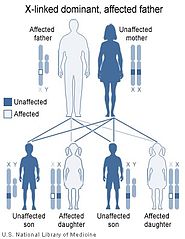Bazex-Dupre-Christol syndrome
| Bazex–Dupré–Christol syndrome | |
|---|---|
| Bazex–Dupré–Christol syndrome is inherited differently from each parent |
| Classification |
· ·
|
|---|
Bazex–Dupré–Christol syndrome (also known as "Bazex syndrome", and "follicular atrophoderma and basal cell carcinomas") is a very rare condition inherited in an X-linked dominant fashion. Physical findings typically include follicular atrophoderma, multiple basal cell carcinomas, hypotrichosis, and hypohidrosis.
This condition should not be confused with the unrelated condition acrokeratosis paraneoplastica of Bazex, which may also be referred to Bazex syndrome.
BCDS is inherited in an X-linked dominant manner. This means the defective gene responsible for the disorder is located on the X chromosome, and only one copy of the defective gene is sufficient to cause the disorder when inherited from a parent who has the disorder. Males are normally hemizygous for the X chromosome, having only one copy. As a result, X-linked dominant disorders usually show higher expressivity in males than females.
As the X chromosome is one of the sex chromosomes (the other being the Y chromosome), X-linked inheritance is determined by the gender of the parent carrying a specific gene and can often seem complex. This is because, typically, females have two copies of the X-chromosome, while males have only one copy. The difference between dominant and recessive inheritance patterns also plays a role in determining the chances of a child inheriting an X-linked disorder from their parentage.A locus of Xq24-q27 has been described. However, no gene has been identified.
Genetic testing--x linked dominant pattern associated with various neoplasm (eg. basal cell carcinoma)
...
Wikipedia


